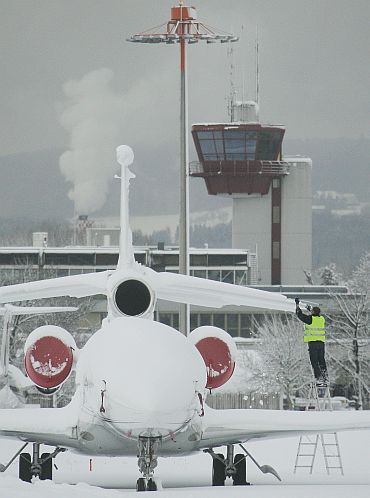 | « Back to article | Print this article |
Inspired by lotus leaf, students develop green aircraft
FAST FACTS
Student Team: Gowri Shankhar Suresh and Aravind Rajendran (IIT-Roorkee); Hasan Sadhir (Anna University)
Competition: Airbus -- Fly Your Ideas
Theme: A greener aviation industry
Project: Prevent formation of ice on aircrafts instead of melting it once formed
It all began when student Gowri was surfing through a website called Studentcompetitions.com that features student opportunities across domains and countries.
He learnt that Airbus was organising the second edition of the "Fly Your Ideas" contest, which challenges university students from around the world to develop new ideas for a greener aviation industry. Gowri joined hands with Arvind, a college mate and Hasan to form Team O3 under the mentorship Professor R Jeyaganthan of IIT-Roorkee.
International runway
Fly Your Ideas (FYI) challenge gives students the opportunity to address one of six issues facing the air transport sector: energy, efficiency, affordable growth, traffic growth, passenger experience, and community friendliness.
Over 2,600 students from 75 nationalities made up the 315 teams that entered the first round. Of these, 84 were selected to advance to Round 2. Five teams with the most exciting projects were chosen in May 2011, and advanced to the final round.
The winner was announced at the Paris Air Show in June 2011. Prizes on offer were 30,000 Euros first prize (grabbed by the Chinese team) with the runner-up bagging 15,000 Euros (Chile team). Team O3 made it to the finals and were flown to Paris.
Whilst their innovative approach to prevent aircraft icing by using water-repelling polymer coatings did not claim top prize, all team members have been offered an internship at Airbus.
Please click NEXT to continue reading
'Our project focussed on preventing the formation of ice, rather than removing it'
Prevention less costly than cure
"Our project mainly focussed on preventing the formation of ice on the aircraft surface rather than its removal. The formation of ice increases the drag force while reducing the lift force causing problems with the smooth flight of the aircraft," explains Gowri.
As the aircraft flies through the clouds the super-cooled water in the clouds sticks to the aircraft surface and freezes, explains Aravind. The current solution to the problem is to melt the ice once it is formed.
Nature inspires invention
The most interesting thing about the project is that the inspiration is drawn from Mother Nature itself.
"We prepared a water repelling coating inspired by the surface characteristics of the lotus leaf which is extremely difficult to wet. It is extremely hydrophobic and the water drops on it are almost a perfect sphere," says Gowri.
Team O3 produced pores in polymer surfaces to get similar structures to the lotus leaf, enabling water repelling.
"We found a way to coat this polymer onto the aircraft surface, which can withstand high stress under avionic conditions by adding another material with a low melting point to bridge the polymer and aircraft surface," says Aravind explaining the mechanics involved.
'Our innovation provides a highly efficient and eco-friendly solution'
Saving fuel, reducing pollution
According to the team, this proposed solution can reduce the usage of aircraft de-icing products prior to takeoff thus saving money and reducing pollution.
This would also reduce the weight of the aircraft as on-board anti-icing equipment would no longer be required, and consequently reduce fuel usage.
"Also, conventional de-icing products are temporary and have to be sprayed prior to every take-off but this coating is for a long term and has a lifetime of a few years," they explain.
The project addresses a significant problem faced by the avionics industry in India.
"During winter, most of North India experiences icing. Our innovation provides a highly efficient and eco-friendly solution. This is not just limited to commercial aircraft and can also be used in other types. It is required to coat this material on the outer surface of the aircraft in order to make this effective," says Gowri.
Materials used
Ask the budding engineers about the contents of their innovation and pat comes the reply, "Our product is mainly made of a silicone polymer in which pores are created by adding a porogen solvent like Tetrahydrofuran and when the porogen is quickly made to evaporate it leaves pores behind. We also add a low melting point oligomer to form a bridge during the coating to withstand stress," they explain.
A green solution
According to them, it is eco-friendly because it does not leave any non-biodegradable residue behind even when it degrades and it also reduces the usage of harmful ethylene glycol and propylene glycol which is currently used for de-icing.
These glycols contaminate drinking water, harm aquatic lives and workers near the airport area.
Seems like the new breed of Indian engineers has firmly decided to make world a better place to live in, and earned the country some laurels in the process.


